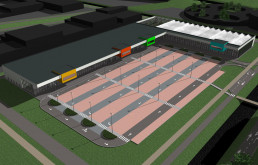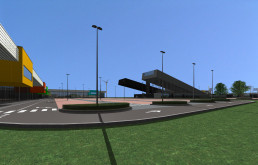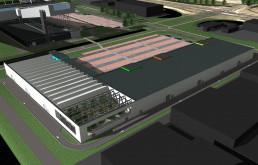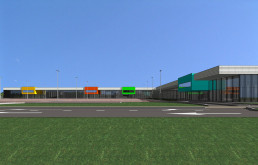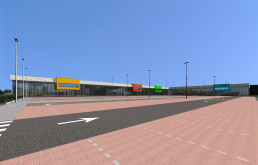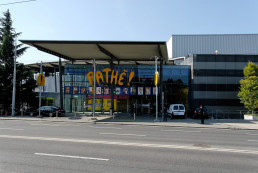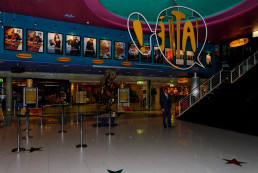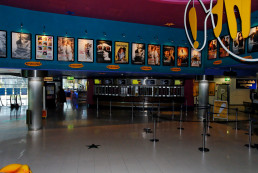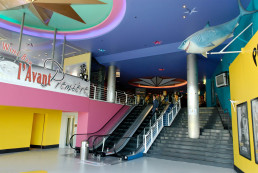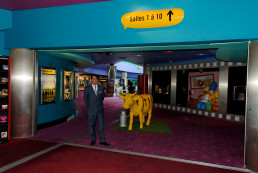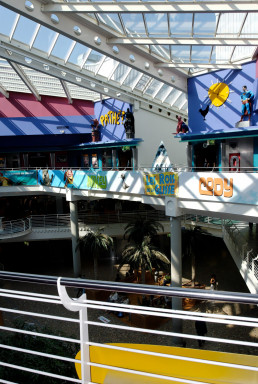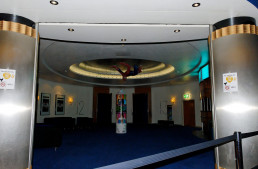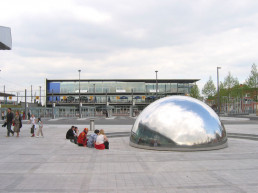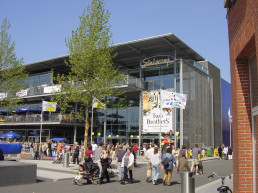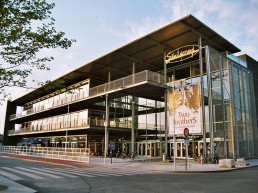Namur Station
Namur Station
Namur is the capital of the Belgian region of Wallonia and seat of the Walloon public institutions. Plans are in place to redevelop Namur so that it can do justice to its city status. The station and surrounding area – the hub for transport links to the outside world – plays a key role in this makeover.
Architecturally, the plan is expressed through the use of a modern design, contemporary materials and a pure composition. The proposed design gives the station the look that its social role demands and turns it into a true centrally-located orientation point in the city. The point of departure adopted in including the building in the area’s urban development plans is one of architectural antitheses.
This contrast in architectural expressions (the classical station and the modern MET building and platform) guarantees the positive re-evaluation of the urban quality – a position confirmed by the Leuven station, with the contrast between the old station building and the new platform awning serving as an excellent example of this aspect.
The general cityscape is echoed by “metal waves”, which serve to extend the existing morphology and design. These waves refer to the station’s archetype, the glass vault and the dome.
Project Koegorspolder Terneuzen second phase
Project Koegorspolder Terneuzen second phase
Property developer Olivier Beherman of Health Invest has submitted a plan to the Terneuzen municipality for developing the second phase of the northern Koegorspolder. Beherman hopes to construct a 9,750 m2 large-scale retail centre to the east of the Skidôme winter sports centre, along with several hundred parking places. The retail centre will cost around 6.5 million euros to construct, and Beherman already has a guaranteed buyer. There has been particular market interest in creating a garden centre in the new facility.
Beherman, a property developer and owner of the Skidôme winter sports centre, had finalised the construction plan last year but was compelled to hold off because he first needed to find a new manager for the wintersportscenter, which happened last October when Rucphen entrepreneur Nicky Broos took over Skidôme. He vigorously set about recapturing the winter sports market on both sides of the Belgian-Dutch border.
The property developer is well-aware of the fact that the property he owns in Koegorspolder is still designated for agricultural use, and that there is a long road to travel for its re-designation. “But developments have not come to a standstill in Terneuzen either,” he says. “Work is progressing well on the new roads infrastructure required for the construction of the Sluiskil Tunnel. In the near future Koegorspolder will be the heart of Zeelandic Flanders, with connections to both Flanders and the Zeeland midlands. The area around the indoor ski slope will then be transformed into the urban fringe of Terneuzen, which means there will be many opportunities. And not taking advantage of them would, from the point of view of Terneuzen municipality, be very unwise indeed,” says Beherman.
The Belgian property developer is not alone in that view, with AVV Beheer Terneuzen, which owns over five hectares of land in Koegorspolder (previously the property of AM Wonen), likewise stating that the municipality must soon reach a decision on the development of the urban fringe. To date the Terneuzen municipality has only wanted to permit large-scale retail in the Kennedy-West planning area. Local authorities have been discussing that area’s development for years with Lafoma property developers and the construction company Van der Poel, but concrete plans have as yet never been presented.
Beherman believes that the Kennedy-West development is not feasible and the market has shown very little interest in it. “But for the Koegorspolder there is still interest, despite the setbacks we have encountered. Terneuzen will have to finally make a decision, and by submitting our plan – for which, for that matter, BAM Utiliteitsbouw has already put itself forward – we hope to convince the municipality that Terneuzen’s development potential lies to the city’s south. It is Terneuzen – and not the province of Zeeland – that is going to have to make a decision,” says Beherman.
Pathé Cinema Complex, Switzerland
Pathé Cinema Complex, Switzerland
The cosmopolitan area of Geneva is the smallest of the large financial metropolises in the world. It is a city where Olivier Beherman developed a cinema that fits into the fairytale Geneva.
The complex is now home to Pathé and houses 13 cinema screens. To complete the happiness of the visitor there is a restaurant and also a Mövenpick ice cream parlor.
Architect:
HR Lewis
Contractor:
Cosimco / B&E
Station Sint-Niklaas
Sint-Niklaas Railways Station
Redevelopment of the Sint-Niklaas Railways station, a 24.000 m² area encompassing an 8-screen multiplex, a new shopping center and several eating facilities.
The project proved to be a successful Public-Private cooperation and transformed an unpleasant , rather bare space into a lively place in the heart of the city.
Skidôme Terneuzen
Skidôme Terneuzen
The indoor ski slope forms the main attraction of this broad multipurpose real estate development. The total land area for the ski slope, the retail centre and the parking accommodation encompasses 6 hectares. The site is located on the periphery of the city of Terneuzen, 200 meters south of the regional highway connecting Terneuzen to Ghent, Antwerp and Rotterdam.
Formula
A catalyst for growth in the leisure market is the emergence of new and exciting leisure venues. These new venues stimulate demand by creating attractive entertainment experiences in secure environments with accessible locations. The schemes are becoming larger and more sophisticated in terms of lay-out, scale and flexibility, being multi-facility venues providing diversity, variety and convenience. They collect together a mix of leisure uses, which may include elements of retailing and create a broad based customer appeal.
The leisure market has emerged in much the same way as the out-of-town retail. Both have progressed significantly since the first generation schemes of the early 90’s. These were often converted industrial buildings whereas the latest generation are ‘state of the art’ open parks. The market situation for the implementation of an indoor ski slope combined with a retail centre in Terneuzen has been assessed favorably for the following reasons:
- The growth of the leisure market in general. Simultaneously the market for mono-functional formulas has decreased;
- The broad operating formula of the retail centre whereby several target groups are reached;
- A large catchment area with a high population density on the Flemish side;
- There are no indoor ski slopes within the trade area and no large retail centres within the catchment area.
The building combines and integrates a large and coherent program of entertainment, sports and recreational retail activities. This synergy is achieved as follows:
- Synergy in Time: beside the ski slope as a trigger of this multipurpose development it is important that there is always an activity in the centre.
- Complementary Synergy: the ski slope is reinforced with leisure and retail activities that complement each other.
- Nourishing Synergy: food & beverage corners as well as large-scale retail activities stimulate the animation of the centre.
Market Factors
Commercial leisure has been a fast growing property sector in the 2000s. Rapid development has been driven by leisure spending which has outperformed growth in consumer expenditure and is expected to continue to do so over the medium term.
Several of the major operating companies in the leisure industry are reporting good trading results and are now developing those divisions which they consider to be faster growing. Scheme layouts and unit sizes continue to evolve as operators refine and improve their trading formats.
Changing demographics towards an increasingly affluent population, with a growing economic importance of women and an increasing propensity to spend on entertainment away from home, is helping to drive the market. Planning restrictions continue to curb out-of-town development, restrict supply and are expected to underpin values.
Location
The location of Terneuzen was chosen for the following reasons:
- Economic: Very strong economic potential that will enhance further by the development of the Canal zone Terneuzen-Ghent and the increasing interaction between the harbors of Antwerp, Ghent and Rotterdam. In the near future this area will become one large economic axis.
- Catchment area: Terneuzen lies centrally between the cities of Antwerp, Ghent and Bruges and hence embraces a large and wealthy population.
- Infrastructure and accessibility: good infrastructure, easy access to the site and a large free car park.
Operational results
The indoor ski slope opened its doors in July 2008. After several years of operations, the number of visitors continues to increase. Numerous regional companies are organizing events in the centre. Moreover the turnover of the Perry sports shop located in the centre has outperformed the other Perry shops in the Netherlands by achieving the highest turnover per m².
Future developments
The whole site has a gross surface of 520.000 m². Health Invest owns and controls 180.000 m². In a second phase Health Invest plans to proceed the development of the site by envisaging a large garden and do-it-yourself (DIY) centre for the whole region.


